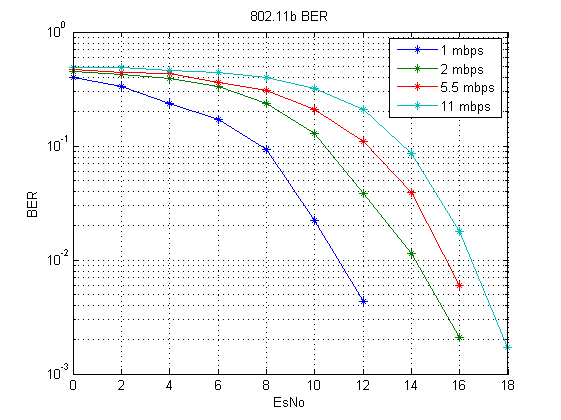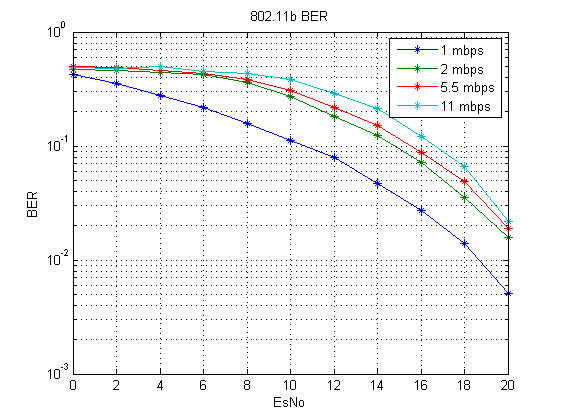IEEE 802.11b multipath channel simulation
Multipath channel models
In this paper, we consider the influence of the environment on the reception of signals of the IEEE 802.11b standard in conditions of being in a room. The influence of three types of propagation channels is considered: the Gauss channel, the Rice channel and the Rayleigh channel.
The radio signal on the path of propagation from the source to the receiver may encounter obstacles. In this case, the signal can be absorbed by them or reflected. The reflected signal will reach the receiver, but it will happen late. On the other hand, the remaining signal energy can reach the receiver without re-reflections in a shorter time or pass more reflections, which in turn will lead to even greater delays. This effect occurs when several signal delivery paths occur between the source and receiver. In this case, the signal energy will be unevenly distributed between copies of the signal. This signal propagation is called multipath.
The study includes an analysis of the influence of various characteristics, such as Doppler shift, propagation delays, re-reflections, attenuation of the signal power on a multipath channel. The result of the study are the characteristics of the probability of error signals at different speeds.
')
The Gauss Channel is a channel with additive white Gaussian noise. This channel is the ideal channel without fading and multipath propagation. This channel will serve as a measure of the quality of the implemented algorithm for receiving signals, the assessment will be made by characterizing the probability of errors per bit of information (BER).
The calculated BER characteristic can be calculated using the following formulas:
for DBPSK signals
for DQPSK signals
where Q_1 (a, b) is a Markov Q-function and I_0 (ab) is a Bessel function of the first kind with parameters a and b:
BER for CCK coded signals is defined as:
In the Rayleigh and Rice channels, in addition to the additive component of noise, there are multiplicative noises caused by reflections and movements of objects in the medium. The passage of the signal through the channel can be represented as follows:
Gauss additive channel:
 (Direct visibility, no echoes).
(Direct visibility, no echoes).Rice Canal:
 (Direct visibility, there are reflected signals).
(Direct visibility, there are reflected signals).Rayleigh Channel:
 (There is no line of sight, receiving only reflected signals).
(There is no line of sight, receiving only reflected signals).The signal was generated according to the IEEE 802.11b standard, the “raised cosine root” filter was selected as the shaping and matched filters. Filters are used to eliminate intersymbol interference (Fig. 4 and Fig. 5). Reception of the signal is made according to its own algorithm. All algorithms are made in the language MATLAB R.

Fig.4 constellation after passing the channel

Fig. 5 constellation after matched filter
To form channel models in the Matlab environment, you need to use the following functions: awgn — for the Gauss additive channel, ricianchan, and rayleighchan — for the Rice and Rayleigh channels, respectively.
The Rice Channel is characterized by the following set of additional parameters: fading, Doppler frequency, Rice coefficient of the power ratio in the rays, as well as attenuation. The Rayleigh channel has the same effects as the Rice channel, but the difference between these channels is the absence of a direct beam from the transmitter to the receiver.
The Doppler effect occurs when the relative movement of the receiver and transmitter, or when moving objects in the signal path. Since the considered standard is intended for transmitting signals indoors, in the Rice channel the Doppler shift frequency can be set to f_d = 11 Hz, which corresponds to a receiver speed of 5 km / h at a 2.4 GHz carrier frequency. At a non-zero frequency of the Doppler shift, the signal constellations will blur (Fig. 5).
The values of the attenuation and delay in the propagation of signals in multipath channels were taken from [6] , studied specifically for signals of the IEEE 802.11 standard. This paper presents the values of three different models:
Model A is a typical office space with the absence of direct visibility, the root-mean-square delay of propagation is 50 ns.
Model B - open space or large office space, lack of direct visibility, root-mean-square delay of 100 ns.
Model C - large spaces (both for rooms and for streets), the absence of direct visibility, the root mean square delay of 150 ns.
In this work, the model B is used, for which the following parameters are characteristic:
For the Rice Channel:
f_d = 11 Hz; K = 20;
τ_i = [0 10 20 30 40] (ns); α_i = [0 -5.4 -10.8 -16.2 -21.7] (dB)
For the Rayleigh Channel:
f_d = 11 Hz;
τ_i = [10 20 30 40] (ns); α_i = [- 5.4 -10.8 -16.2 -21.7] (dB)
There are no zero components in the Rayleigh channel due to the absence of a direct beam.
After passing through the channel, the signal is fed to the input of the receiver.
Algorithm of reception, if necessary, I can give.
Simulation results
When calculating the noise immunity characteristics, 50000 bits of information were encoded by DSSS (1 and 2 Mb / s) and CCK (5.5 and 11 Mb / s). To calculate the characteristics of the signal was reduced to the power of 1 watt. The noise immunity characteristics were obtained for three channels: the Gauss channel, the Rice channel and the Rayleigh channel (Fig. 6-8), the choice of parameters for each channel is indicated above.

Fig. 6 Characteristics of noise immunity for the Gauss channel.

Fig. 7 Characteristics of noise immunity for the Rice channel.

Fig. 8 Characteristics of noise immunity for the Rayleigh channel.
In fig. 6-8 signal-to-noise ratio is given in decibels (abscissa axis). These results illustrate the noise immunity of the 802.11b signal in multipath channels for large rooms or open spaces. The frequency of the Doppler shift within 120Hz does not have much effect on the BER characteristic.
The difference in the characteristics of the Rice and Rayleigh channels is due to the absence of a direct beam in the Rayleigh channel from transmitter to receiver.
Characteristic of noise immunity as a function of the K coefficient (Rice coefficient) for the Rice channel: (Fig. 9).

Fig. 9 Dependence of the BER characteristic on the K coefficient in the Rice channel.
From this characteristic it can be seen that with an increase in the ratio of the main power to the power of the reflected rays, the characteristic improves. When K = 0, there is no direct beam, only reflected rays are accepted, which corresponds to the Rayleigh channel characteristic.
Bibliography
1. IEEE 802.11-2007 (Revision of IEEE Std 802.11-1999) NY 10016-5997, USA
2. “The Basics of Building 802.11 Wireless Local Area Networks”, Pedzhman Roshan, Jonathan Leery, Ed. Cisco Press 2004
3. “Modern technologies of wireless communication” Shakhnovich I.V., 2 Ed. “Technosphere” 2006, 288 p.
4. “Broadband wireless information transmission networks” V. M. Vishnevsky, A. I. Lyakhov, S. L. Portnoy, I. V. Shakhnovich, Izd. “Technosphere” 2005, 591 p.
5. “Foundations of local networks” Yu.V. Novikov, S. Kondratenko Internet University of Information Technology - INTUIT.ru, 2005
6. “TGn Channel models”, Vinko Erceg, Laurent Schumacher, 2004, 45 p.
7. “Simulation of Communication Systems”, Jeruchim, MC, Balaban, P., and Shanmugan, KS, Second Edition, New York, Kluwer Academic / Plenum, 2000
This is part of my thesis on the topic “Development of a simulation model of paths for the formation, distribution and reception of signals from IEEE 802.11b networks”, since the work is large, I did not publish everything, but published, in fact, only conclusions.
I will try to answer all your questions. I can help and put the source code on Matlab, if anyone needs.
Source: https://habr.com/ru/post/122544/
All Articles